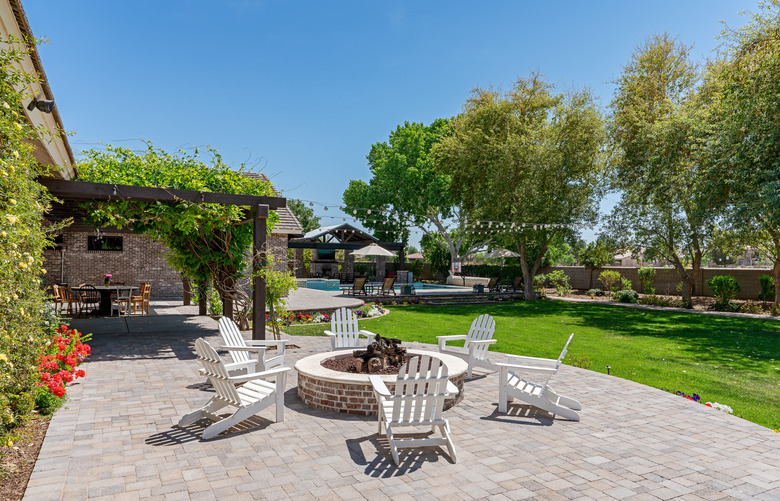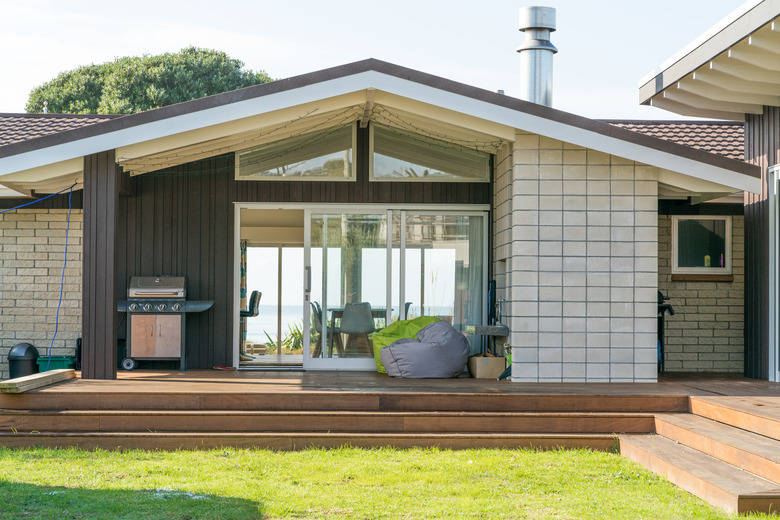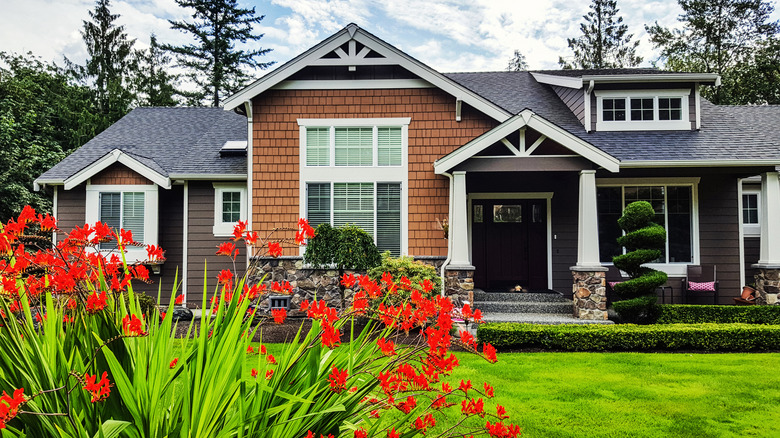A DIY Guide To Leveling A Bumpy, Uneven Lawn
We may receive a commission on purchases made from links.
A bumpy, uneven lawn isn't just less attractive — it's also harder to mow and can even be dangerous to play or walk on. Dips in a bumpy lawn can even result in drainage problems when the water settles into low spots, which can cause disease in your grass and can even turn your yard into a mosquito breeding ground. The solutions to fix an uneven lawn will vary based on the severity of the problem and can be as simple as top-dressing low areas of the lawn or as difficult as regrading the entire yard.
Evaluating an Uneven Lawn
Evaluating an Uneven Lawn
Start by mowing the yard as best you can, even if it's hard because the lawn mower tends to jump and bounce thanks to all the low spots. While you may know you have a bumpy lawn, you need to find where the dips actually are located by using a straight, 8-foot-long 2x4 to look for low spots. Add a screw eye into each end of the board and then tie a long piece of rope to each eye so you can drag the board along the yard and evaluate the depth of your dips.
If you notice that any low spots are particularly wet, find out if they happen to be located above water pipes (if you're uncertain, you can call 811, the national call-before-you-dig hotline). If this is the case, the problem could be a leaking pipe, and you'll need to repair the pipe before repairing your lawn.
Remove Excess Thatch
Remove Excess Thatch
Sometimes, the cause of an uneven lawn is something as simple as excess thatch. Thatch is the brown layer of dead grass, roots and crowns that sits between the soil and the green part of the grass blades. Overgrown thatch can cause drainage issues since it prevents water from getting into the soil, resulting in bare spots where the grass has died out or high patches where the roots have started to grow above ground in order to access nutrients that are no longer reaching the soil. Even when thatch isn't the problem, it should usually be removed before repairing holes in order to help your lawn grow back healthier.
To see if thatch is your problem, cut out a chunk of grass to look at the thatch. If the thatch is over 1 inch thick, you'll need to dethatch the yard and then re-examine it to locate dips in the soil. It's best to do this during the active growth phase of your grass type, so if you're growing cool-season grasses such as bluegrass, rye or fescue, you'll want to work in fall. For warm-season grasses, such as Bermudagrass, zoysia or carpetgrass, you'll want to dethatch your yard in spring.
You can dethatch with either a dethatching rake or a motorized dethatcher. After dethatching, aerate the yard to make it easier for nutrients and water to get into the soil. Fertilize after aerating to ensure the grass will quickly grow back into a healthy lawn.
For Minor Holes
For Minor Holes
Over time, all grass will naturally become a little bumpy here and there. Most of the time, this is a result of slow and subtle changes to the ground, such as mild erosion, weather changes, wheelbarrow tracks, digging by pets, pests like moles or gophers or even insects like earthworms or ants. The good news is that minor dips (those under 1 inch deep) in an otherwise healthy lawn can usually be fixed fairly easily without even needing to reseed.
Top-dress the area with a thin layer of mix made of 30 percent potting soil or compost and 70 percent play sand. The sand is perfect for filling in gaps, improving drainage and leveling dips. But if your soil is clay, adding too much sand is detrimental, particularly if you use a fine grade such as play sand. In the presence of rain or irrigation water, the sand mixes with the clay to form a hard surface almost like concrete, and this hard top layer is difficult for plant roots to penetrate. Soil or compost added as a topdressing, however, provides nutrients to the grass.
Only use 1/2 inch of top-dressing at once to avoid crushing and smothering the grass. Use the backside of a leveling rake, push broom or gardening rake to spread out and work the top-dressing into the grass until it is mostly even, and the grass blades come out above the surface. Water the grass to help promote growth and to stabilize the top-dressing. Add a second half layer of top-dressing and level if necessary, always being careful to work into the grass so it comes out through the top of the soil.
You should see more grass than soil after spreading in the top-dressing, but you may need to overseed if you notice any areas where the grass is too thin because it was too short to come through the top-dressing.
For a Moderately Bumpy Lawn
For a Moderately Bumpy Lawn
For dips and ruts over 1 inch deep, you'll need to level the underlying soil and then either resod or reseed to have a level lawn. If you have an otherwise healthy lawn and want to keep the grass, try to carefully cut out the turf in 1-foot-wide squares with a squared-off shovel. Pull up the squares gently and set them aside in a shady place where they won't dry up so they can be replanted later. If you're planning on planting new grass or sod, you can just work right on top of the existing grass.
Next, fill the hole with a top-dressing mix made of 50 percent topsoil and 50 percent sand (or compost if your soil is clay). (The 30/70 mix used for smaller divots gets too hot in the sun and provides too few nutrients for larger areas.) Add water to help settle the top-dressing and to remove air pockets. Further even out the soil with a leveling rake or the backside of a landscaping rake and remove air pockets by walking on it or tapping it down gently with a shovel (avoid lawn rollers, as these can overcompress the soil and reduce aeration).
If you're reusing your old grass or laying down sod, leave the soil level in the hole area 1/2 inch lower than the surrounding grass. Cut the sod to fit your hole and then gently lay it down, adding grass seeds along any seam areas and water well. For seed, make sure the dirt is fully level and then sprinkle your grass seeds and water thoroughly.
For Severely Uneven Lawns
For Severely Uneven Lawns
If you have a severely bumpy lawn that is covered in craters, you may need to take the more extreme measure of regrading the whole lawn. While fixing mild to moderate dents in a yard is a simple-enough DIY project, regrading a lawn is a major undertaking, and it may be preferable to hire a landscaping company to take over the project for you, especially if you have a large yard.
When planning the grade for your yard, make sure the slope goes away from your home to ensure that water doesn't pool up against the foundation of your home. Remove the topsoil from the sections of your yard that need to be fixed. Use a shovel and leveling rake to dig and scrape away high spots and fill in low spots.
Spread 2 inches of topsoil over the area being repaired and till into the soil below to improve drainage. Add more topsoil until it is even with the rest of the yard or any bordering walkways or patios (leave 1/2 inch of space if you are installing sod). Then, lay down sod or grass seed and water thoroughly.


